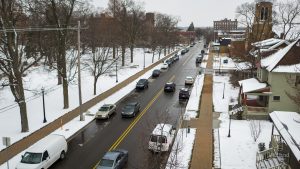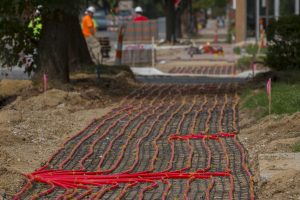By Michelle Gibbs, Holland-Hope College Sustainability Institute

Did you know, in the City of Holland we have the largest municipal snowmelt system in the United States?
After the recent expansion, the system provides more than 600,000 square feet of heated sidewalks and streets. Personally, I love walking around downtown and not worrying about slipping on the ice or having my shoes ruined by the snow and salt, but did you know there are many other benefits to this unique system?
Here is the story of that system – how it came to be, how it works, and its benefits to our community economically, socially, and environmentally.
History: We have enjoyed the benefits of the snowmelt system since 1988 thanks in large part to Edgar D. Prince, Prince Corp. founder, who brought the idea of the snowmelt system to city officials after a visit to Europe. Over the years, the system has expanded to meet growing needs of the community.

How it works: Excess heat from generating electricity at the Holland Energy Park is captured in the cooling tower, and warm water is pumped through a large underground pipe to downtown Holland. The water is then circulated through 190 miles of smaller tubing. This closed loop system means the same water is circulated over and over again at 95 degrees Fahrenheit. In the past, the system pulled its water from Lake Mactawa, but switching to a closed loop system reduces sediment and wear on system valves.
Economics: In the late 1980s and the 1990s, the snowmelt system played a part in the revitalization of Holland’s downtown. Business owners rallied with the city and Holland Board of Public Works to create a vision for an attractive, snowfree downtown, and the system became a part of that vision to help our community grow. Our downtown now offers a variety of stores, boutiques, restaurants, galleries, and even a winter farmers market.
Socially: The snowmelt system helps bring people together, as even on the coldest of days you still find people downtown. A number of community groups even meet downtown so they can walk or run without the fear of slipping. The recent system expansion helped connect downtown to the farmers market area near the Civic Center, Herrick District Library, police department, and various parking areas.

Environmentally: Typical power generation systems discharge their waste hot water to the environment; however, the closed loop system greatly reduces the discharge to local bodies of water. Another environmental benefit is the reduced use of salt to melt ice and snow. “Salt is a pollutant that is harmful to fish and wildlife, so we are always happy to see a reduction in its use,” notes the Macatawa Watershed Project.
Holland Energy Park has the potential to support a snowmelt system five times the current size and to provide additional community resources such as district heating for downtown buildings. The Civic Center is set to be the first building in Holland heated with support from water from the snowmelt system, making it very energy efficient.
Snowmelt has become a part of our identity and is one of the ways Holland continues to “make big ideas come alive.”
WZZM 13 News Segment on Holland’s Snowmelt
To learn more about this unique resource, please click the links below to see photos, videos, and maps of the system:
https://www.cityofholland.com/streets/snowmelt
http://www.holland.org/snow-free-holland
Michelle Gibbs is the director of the Holland-Hope College Sustainability Institute. The vision for the Institute is a healthy and economically vibrant community that promotes environmental stewardship and mutual respect for people and the planet. Our mission is to foster collaborative efforts to infuse sustainability into the minds and practices of the greater Holland community.
Snowmelt by the Numbers:
4.9 miles of heated streets and sidewalks
114,000 square feet of streets are warmed
534,000 square feet of sidewalks and parking lots are warmed
5,500 gallons of water per minute pumps through the system
Melts about 1 inch of snow per hour at 20 degrees with light winds
![]() This Week’s Sustainability Framework Theme
This Week’s Sustainability Framework Theme
Transportation: The movement of people, goods, and services within the area links us to our regional, national and global networks.
![]() ABOUT THIS SERIES
ABOUT THIS SERIES
Living Sustainably is a collection of community voices sharing updates about local sustainability initiatives. It is presented by the Holland-Hope College Sustainability Institute, a joint project of Hope College, the City of Holland and Holland Board of Public Works. Go to www.hope.edu/sustainability-institute for more information.

